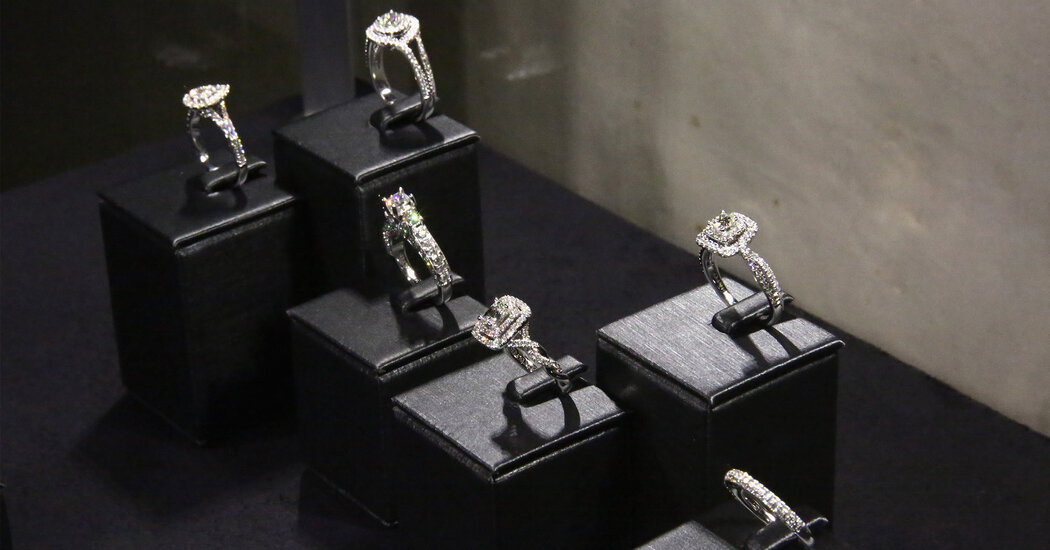Aftershocks from the coronavirus pandemic continue to rumble through the US economy, and Signet Jewelers shared a surprising one this week: The company is selling fewer engagement rings this year because, it says, singles stuck at home during lockdowns fell short of expectations – Engaged are in 2020.
“As we predicted, there were fewer orders in the quarter due to Covid’s disruption to dating three years ago,” Virginia C. Drosos, the CEO of Signet, owner of Kay Jewelers and Zales, told investors Thursday. Shares of Signet, the largest jewelry retailer in the United States, plummeted after the company cut its forecasts for sales and earnings for the rest of the year.
In a way, the engagement ring has become a scintillating microcosm of the American economy. The bridal jewelry trade has been wracked by the delayed effects of the pandemic, rapid inflation weighing on consumers and a growing sense of nervousness among shoppers.
Part of the volatility is purely due to the pandemic. Weddings were canceled en masse during the 2020 lockdowns, but recovered from late 2021 and throughout 2022, and were expected to level off in the coming years as more typical patterns returned. Marriage-related activity appears to be showing some early signs of slowing down in 2023, but it’s unclear whether that’s the result of a dry dating spell in 2020, according to Signet, or simply a return to the long-standing shift toward later and fewer marriages.
What is clear? Wedding trends are also linked to broader and potentially more sustainable economic forces. Signet may be selling less as fewer people get down on one knee, but also as ring buyers become more cautious and spend less amid rapid inflation and growing uncertainty about the direction of the economy. Both the volume and the value of jewelry sold by Signet decreased last quarter.
Ms. Drosos said the company had “expected the low-double-digit drop in orders we saw this quarter” but that other factors were at play as well. “Recent consumer confidence, lower tax refunds, economic concerns caused by regional bank failures and continued inflation have led to a weakening trend in spending in the jewelry industry,” she added.
Consumers face major challenges this year. Prices have increased cumulatively by about 15 percent over the past three years, as measured by the Personal Consumption Expenditures Index. Inflation has eased in recent months, but many workers are finding their wages falling behind.
The Federal Reserve has raised interest rates to try to cool the economy and counter stubborn price increases. In addition to making it more expensive for consumers to shop or take out loans on credit, the rate changes have increased the likelihood of the economy slipping into recession. This uncertainty has been exacerbated by the recent turmoil in the banking sector.
As many households see their savings dwindling and worry about their job security in a weakening economy, they may be less willing to splurge on expensive items like fancy diamond rings and custom wedding dresses.
David’s Bridal, the wedding dress retailer, suggested in a bankruptcy filing this year that some brides had become increasingly budget-conscious.
“More and more brides are opting for less traditional wedding attire, including frugal wedding dresses,” James Marcum, the company’s CEO, said in a lawsuit.
Like much of the economy, the wedding industry has shown signs of a split as higher earners find they are able to tap into their savings and continue to spend, and lower income families spend a larger portion of their income on necessities like food are beginning to burst under the weight of inflation.
LVMH, the luxury retail group that owns jewelry stores including Tiffany, reported continued growth in early 2023, including solid growth in jewelry.
“Everyone expected 2023 to be a horrible year for luxury in the US,” Jean-Jacques Guiony, LVMH’s chief financial officer, told investors in April, explaining that a collapse had not materialized. “It’s normalizing, but it’s not bad either.”
But with more mass-market brands like Kay Jewelers and Zales, shoppers may be starting to pull away.
“We started to see weakening at higher price points, which had previously been relatively isolated, and lower price points continued to be under pressure,” Joan Hilson, chief financial officer of Signet, said on Thursday’s call.
Signet hopes wedding ring demand will rebound: It predicts 500,000 more engagements in the United States from 2024 to 2026 than the prepandemic trend suggests as dating slowed by the lockdowns leads to matches.
But Shane McMurray, founder of the Wedding Report, is skeptical of a major gap year in engagements. He expects weddings to drop 20 percent in 2023 from 2022 as trends return to normal. And Lyman Stone, director of research at the consulting firm Demographic Intelligence, agreed that the current slowdown in weddings could reflect a return to earlier trends rather than a one-time weakening.
“It looks like 2023 is going to be a low year,” he said. “I think it’s a bit tense to blame the lockdowns in 2020 for that.”

